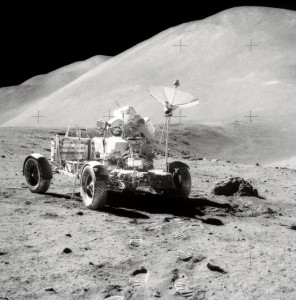 On this day in the year of 1969, Apollo 11 Astronaut Neil Armstrong was the first man to set foot on the moon. A few short years later in 1971, Apollo 15 Commander David Randolph Scott became the first man to drive on the moon. The Lunar Roving Vehicle, or LRV, went the distance folded up under the Lunar Module. The LRV was deployed and loaded up with tools by the Astronauts on the moon. The LRV was fully electric, with 10,000 RPM wheel mounted motors for motivation, and a set of silver-zinc potassium hydroxide batteries providing the juice. LRV development spawned more than a few different prototypes and configurations on the way to the final and famous lunar going version we know today. In honor of the legendary achievements of the Apollo Space Program, and Apollo 16 Commander and LRV driver John Young getting the moon buggy moonborne off the edge of a crater at eight miles per hour, we present just a few examples of Apollo Space Program LRV history from at the NASA photo archives. All NASA images courtesy of nasaimages.org.
On this day in the year of 1969, Apollo 11 Astronaut Neil Armstrong was the first man to set foot on the moon. A few short years later in 1971, Apollo 15 Commander David Randolph Scott became the first man to drive on the moon. The Lunar Roving Vehicle, or LRV, went the distance folded up under the Lunar Module. The LRV was deployed and loaded up with tools by the Astronauts on the moon. The LRV was fully electric, with 10,000 RPM wheel mounted motors for motivation, and a set of silver-zinc potassium hydroxide batteries providing the juice. LRV development spawned more than a few different prototypes and configurations on the way to the final and famous lunar going version we know today. In honor of the legendary achievements of the Apollo Space Program, and Apollo 16 Commander and LRV driver John Young getting the moon buggy moonborne off the edge of a crater at eight miles per hour, we present just a few examples of Apollo Space Program LRV history from at the NASA photo archives. All NASA images courtesy of nasaimages.org.





I read years ago that some of the Rover designers were Model T fans and integrated a bead roll on the fender to honor their favorite cars. The designers said it was to strengthen the part.
I’ve only seen that mentioned once, and haven’t been able to verify.
Duct tape, EVA maps, and a couple clamps from the Lunar Module were used to repair a broken Apollo 17 LRV fender. The repair parts, covered in moon dust, are at the Smithsonian Air and Space Museum!
Apollo 17 transcript [NASA]